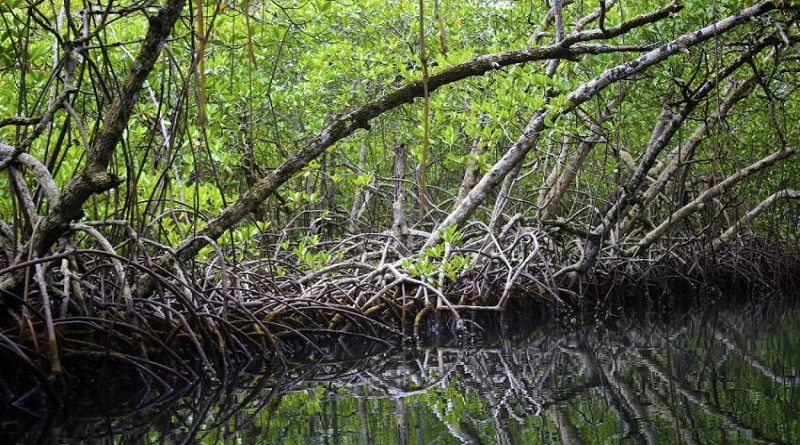New report highlights benefits of ecosystem-based adaptation
As the unavoidable impacts of climate change hit home – including more heatwaves, droughts, floods and cyclones – societies are looking at ways to build resilience. A recently released UN report illustrates that intact ecosystems can often be the most effective and cheapest barriers to such impacts.
Adaptation to climate change is usually associated with built infrastructure, such as elevated roads and concrete sea walls. But “Ecosystem–based” adaptation strategies are important to consider as societies implement the Paris Climate Change Agreement, along with the national climate action plans under the agreement.
Ecosystems that provide protection from climate impacts range from the humid Amazon rainforest in South America to the mangroves along the Moroccan coast in West Africa. Tropical rainforests both absorb carbon dioxide and can stabilize water supplies and safeguard inhabited areas from flooding. And mangroves provide the best natural defences against storm surges.
Whilst protecting against weather extremes, such valuable ecosystems are also under increasing pressure from climate change. For example, damaged forests cannot effectively store water. And a coral reef structure weakened by warming and acidification will be less effective in protecting against storm surges.
The UNFCCC report “Adaptation planning, implementation, and evaluation addressing ecosystems and areas such as water resources”, offers three major insights:
There is a close link between healthy ecosystem and its communities’ capacity to adapt. However, ecosystems that are healthy today are still vulnerable to climate change in the future. Therefore, ecosystem-based adaptation should consider both current and future climate risks.
Ecosystem-based adaptation actions also contribute to curbing greenhouse gas emissions. Healthy ecosystems can function as a two-prong solution because they reduce emissions from ecosystem degradation while at the same time protecting communities from climate change impacts. Hence, it is an avenue for a holistic approach to sustainable development.
National governments should consider ecosystem-based adaptation as part of an overall approach in their adaptation and development strategies. While there are challenges in integrating the element of ecosystem in national adaptation plans such as lack of financial instruments and inadequate institutional arrangements, they can be anticipated and addressed.
The report helps answer some critical questions regarding implementing ecosystem-based adaptation, along with highlighting several inspiring examples of ways to enhance the resilience of ecosystems:
Ecosystems-based adaptation is sustainable and has the potential to be implemented in an economically viable way. There are several examples of how ecosystems-based approaches can increase adaptive capacity. The governments of Nepal, Peru, and Uganda are among countries that have successfully included ecosystems-based adaptation in government planning at various levels through the Global Mountain EbA program delivered through a partnership between the German Government, the UN Environment, UNDP and IUCN.
Compared to physical engineering structures such as dykes, ecosystem based solutions are often cheaper. Existing initiatives have demonstrated how a hybrid of green (natural) and grey (man-made) infrastructures can create a win-win solution for the environment, society, and the economy. Singapore, for example, has constructed artificial wetlands as well as a green corridor as part of its strategy to address temperature and sea-level rise.
In places where women, vulnerable, and marginalized communities are involved, communities’ and ecosystems’ resilience to climate change have increased. For example, 400 people in the Ait Baamrane community in Morocco can enjoy potable water transformed from dew and fog thanks to the implementation of a gender-responsive, ecosystems-based adaptation by a non-profit organization Dar Si Hmad. This fog-water harvesting system is also the largest operational one in the world, and has been awarded the ‘Momentum for Change: Women for Results’ by the UN Climate Change Secretariat.
Trade-offs may arise when an activity protects one group of people at the expense of another, or favours an ecosystem service over another. Therefore, monitoring the short-term benefits of ecosystem-based adaptation is not enough; a comprehensive analysis of potential trade-offs, synergies, and unintended consequences under different scenarios is also important.This has for example been done in developing a national integrated coastal zone management plan in Belize, where InVEST (Integrated Valuation of Environmental Services and Trade-offs) – a tool with models for mapping and valuing ecosystem services, was used to value ecosystem services based on a combination of economic, spatial, and biophysical models.
The report was prepared under the Nairobi work programme, the UN Knowledge-for-Action Network for Climate Resilience, in collaboration with members of Friends of EbA (FEBA). It was presented to governments during the last Climate Change Conference in Bonn, Germany, on 8-18 May 2017.




